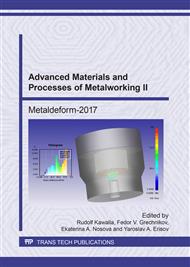p.99
p.108
p.114
p.120
p.126
p.132
p.141
p.148
p.154
Testing of External Cylindrical Surfaces of Car Parts after Wide Burnishing Processing
Abstract:
The hyper productive surface plastic deformation processing technology called as wide burnishing (WB) was developed in Russian Federation. The mechanics of new WB technology is different from the classic SPD technologies (rolling or burnishing). For example applied force during processing of burnishing is 150-300 N, of WB is 2500-5000 N due to condition of process implementation in mass production with limited processing time (3-4 turnovers of workpiece). WB also has a high degree of deformation due to a multiple deformation passes. The requirement to develop the methodology for testing “Gland neck parts of the car LADA processed by various methods” was caused by the fact that the previously carried out bench tests do not reproduce the real surface of necks shafts working in pair with lip seals. As well there was no methodology for measuring the value of the gland neck wear and the maximum value of the wear grooves was defined of 1.0 mm. Specimens reproducing gland neck in two of the most critical parts were tested: flange of cardan shaft mounting to the drive shaft of the gear box made of steel 40 and crankshaft made of high-strength cast iron 75-50-03 of LADA car. Test results of specimens made of steel 40 presented the surface roughness parameter Ra = 0.06 microns after burnishing and Ra = 0.28 microns after polishing. The test results were measured on profilograph and were obtained the following data: the width of the grooves wear was 936 microns with burnishing and 1152 microns with polishing, depth was 2.16 and 4.94 microns respectively. Size of cross-sectional area of specimen’s groove wear with burnishing - 1090 um2, with polishing - 2848 um2.
Info:
Periodical:
Pages:
126-131
Citation:
Online since:
July 2017
Keywords:
Price:
Сopyright:
© 2017 Trans Tech Publications Ltd. All Rights Reserved
Share:
Citation:


